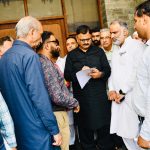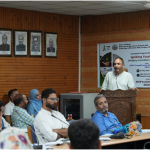FRAGRANCE OF IDEAS
Political activities in our country during the month of December usually remain centered in Delhi. There are two main reasons for that. One is the winter session of the Parliament that is conducted every year in the month of December and the other is the onset of the winter season which brings down the volume of activism in most of the areas that start facing severe cold around this time. But this year, politically speaking, the month of December has been extraordinary due to various factors besides the above referred two reasons. All these developments have naturally blown the bugle for the general elections due in May 2024. It would be appropriate to have an analytical bird’s eye view of the situation as it exists on date.
This year, the results of the recently conducted elections in five states were announced on 3rd and 4th of December thus igniting the spark for the towering political inferno for the rest of the month. Interpretations and analysis of the mandate dominated the post-results scenario in a big way. The winter session of the parliament started on 4th December 2023 in the backdrop of the election results going heavily in favour of BJP. Then on 11 December, the Supreme Court of India pronounced its much awaited judgment on Article 370 and the issues connected with its abrogation that was affected on 5-6 August 2019 through the legislative action in the Parliament.
On 13th December, when the Parliament was observing 22nd anniversary of the terror attack on it and the consequent sacrifices of the security personnel who laid down their lives in 2001, a bad incident took place in the Lok Sabha when two people jumped from the viewer’s gallery into the House and created ruckus therein. Opposition on the very next day started to milk the opportunity and demanded statements from the PM and the HM besides creating pandemonium in the two houses of the parliament. The presiding officers in both the Houses warned the members to desist from any unruly and unparliamentary behaviour but were ultimately forced to take disciplinary action against the members indulging in such activities. Though a formal decision to institute an enquiry was taken and personnel responsible for the security check at the Parliament entry points were also suspended, yet the opposition went into the well of the houses and disrupted the proceedings and the legislative business of the Parliament.
Around 146 members of both the houses were thereupon suspended by the Chairman and Speaker of the Rajya Sabha and Lok Sabha respectively for the rest of the session of the parliament. Some of the suspended members unashamedly orchestrated a ‘circus’ outside the Parliament within the complex before the full glaze of the media and public and brought a very bad name to the parliament and its presiding officers. With this they didn’t only lose the plot but also the sympathy of the people. However, they continued with their protest outside the Parliament complex when they were forbidden to do so within the complex.
All these developments led virtually all political parties and their alliances to assemble in Delhi and start discussions, debates and negotiations in regard to the latest fast-changing and future political developments. Having election results of the five states in view and an eye upon the general elections in May 2024, serious business gathered momentum and the fast developing and evolving political scenario in the country and particularly in the capital caught everybody’s attention. While BJP and NDA took the lead as usual, the Congress and Indi-Alliance also started greasing their organizational machinery. All the developments of the last four weeks declared a virtual political alert and put all the players of the game on tenterhooks.
Every political leader and activist besides their respective parties and organizational mechanism are conscious of the fact that May 2024 general elections would be a historic occasion; historic in many spheres so far as the impact of the elections is concerned. While BJP-NDA would be seriously going for a hat-trick of their victories, the Congress/Indi-Alliance would also leave no stone unturned to stop them from doing so. The biggest advantage of the ruling alliance is its strong, well-recognized and commanding leadership that has a virtual sway on the minds of the people of the nation. The opposition, both singularly as well as collectively, terribly lack in this sphere. It seems unlikely that it would be going for any sort of consensus candidate for the PM’s post during the campaign for the hustings.
BJP has one more great advantage that the opposition has always sidelined consciously and deliberately as not being representative of their so-called India’s political thought. This important aspect pertains to the ideological thrust that the BJP has given to its issues throughout in all situations. The opposition in general has been taking this aspect to the ‘secular-communal’ line of debate without realizing that they have lost a large ground and vote base due to this singular aspect over the last three decades. It doesn’t want to recognize that a new generation has taken over in all spheres of life which has no ideological connectivity or love with the Nehruvian school of thought. People have moved forward and are impressed and influenced by the nationalistic school of thought which BJP has successfully advanced and advocated. It has made a big difference among the educated and literate sections of the society in this regard.
The badly-timed emphasis on the caste oriented issues has backfired for the opposition and particularly for the Congress. Their grip on communities has lost its control since. The way the vote share has slipped from Congress’s hands in four states, which recently went to the polls, speaks volumes about the trend that is yet to take a halt. Congress in the last general elections could not touch even 20% of the total vote share which may hardly go beyond a bracket of 15% to 20% this time. Election arithmetic has been very unkind to the opposition as a whole and Congress in particular because of their very poor strategic thinking and application on the ground. In contrast, the BJP-NDA has been embarking on new areas of penetration and influence consistently. Their think-tank in this direction is always handy and they continue reassessment and reevaluation of their organizational planning and election preparedness.
On the front of development, no argument whatsoever, the opposition can’t counter the genuine claims of the ruling party. Each and every public welfare measure taken by the government for the last ten years speaks for itself. Technically speaking, it is a reverse-incumbency factor that is damaging the cause of the opposition. During the last general elections in 2019, this factor working in favour of the BJP was visible. Both BJP and NDA increased their vote share last time as compared to 2014. That got translated into an increase in number of seats as well. Last time BJP got around 37% of votes while NDA got around 46% of the total votes. This time BJP has strategized to cross 40% of votes leading NDA to touch 50% of the total vote share. In such a situation, the NDA is surely poised to get around 400 seats in the Lok Sabha which will be a comprehensive record. The PM Narendra Modi’s emphasis on 50% vote share target in his recent interaction with the party leaders in New Delhi assumes great significance in this context.
The opposition has been continuously in dirth of any real-time corruption issue of the government that it could have exploited. Though having the backing of a large segment of media within and outside the country, it has failed to make any impact in this direction. Whenever it tried to raise any such issue, it fell flat; sometimes on a political front otherwise on a judicial platform. It could never prove its contention as honest, sincere and trustworthy. Instead in certain cases, the leader/s of the opposition had to tender public apologies for their statements in this regard before the courts, media and public. It has severely damaged the credibility of the opposition. Further, a number of opposition leaders have been facing trials, jails and public fury for alleged corruption charges against them. Then the public has also watched how unaccounted wealth worth crores of rupees, gold and silver as also other valuables were seized from the leaders and activists of the political parties especially Congress.
All these factors put together make a very strong case for the public to think in terms of having a government that they can bank upon as their own with a cherished credibility and past record. In addition to this, over the last ten years, India has successfully emerged as a genuine global leader, achieved its goals in space and technology, given a voice to the global south, earned respect in the geopolitics, played a robust role in combating pandamic, made great advances in the economic sphere, build relationships with other countries, achieved a great breakthrough in the field of international sports, built safe and secure environment for investment, realized goals of huge infrastructure development and attained a rapid and consistent growth in the gross domestic product (GDP) of the country. The opposition will have to walk miles after miles to challenge these humongous achievements and records to convince the masses about their intent and eligibility to provide an alternative.
The way the opposition and especially the Congress (regardless of the existence of the Indi-Alliance) is behaving, it seems that it has reconciled to fight the 2024 elections with a view to further consolidate its position as a strong opposition only. They lack not only the intent but also the purpose to put up a formidable challenge before the BJP-NDA. Then they have the most difficult (almost impossible) task yet to address, i e the sharing of seats at an all-India level. In the largest states (in terms of Lok Sabha seats), the Congress has a very poor position in UP, Bihar, Maharashtra, West Bengal and Tamil Nadu, and the total number of seats in these five states constitute almost 250 seats (46% of the Lok Sabha strength).
Further, the Congress has very less expectations in the states like Gujarat, Rajasthan, MP, Karnataka, Orrisa, Assam, Chhattisgarh, Jharkhand, Haryana and in the North East where it has faced almost continuous defeats for the last five years. However, it can create a fighting situation in Telengana, Andhra Pradesh, Kerala, Punjab, HP and Uttarakhand. But these states return less than 100 seats to the Lok Sabha. The Congress has nothing tangible to offer to its allies at the national level barring minor adjustments here or there. But it expects the other regional parties to leave a chunk of seats to it in the areas under their influence and operation. Whether it is Congress or Indi-alliance, their tally in all circumstances is getting squeezed around 100 seats. The parties like BSP, CPM and CPI have to fight for their own survival only since their existence has been put on stake for the last a decade. They are treated as spent force in the current socio-political scenario of the nation.
The next five months will determine the future course of events and we will have to wait for some more developments to evolve. Elections in May 2024 will finalise the direction of India’s forward movement for another two decades. The people will be expected to judge the situation themselves keeping mainly in view the developments of the last 10 years and the current socio-political situation. Undoubtedly, India’s march towards new destinations in the post-independence era has taken a historical turn over the past one decade. Elections in May 2024 will most probably reinforce the current line of methodology. Any reversal in this regard is surely a lead to vacuum and negation of life. People have enough of time to make a choice, and they are sure to make the best one.
(The author is a senior BJP and KP leader, human rights defender, author & columnist and can be reached at [email protected])








